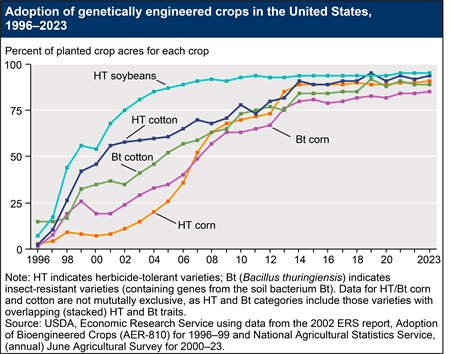
Biotechnology
Genetically engineered (GE) seed varieties were commercially introduced in the United States in 1996. Adoption rates for these crops increased rapidly in the years that followed. Currently, over 90 percent of U.S. corn, upland cotton, soybeans, canola, and sugarbeets are produced using GE varieties.
Herbicide-tolerant (HT) crops tolerate specific broad-spectrum herbicides (such as glyphosate, glufosinate, and dicamba). Insect-resistant crops contain a gene from the soil bacterium Bacillus thuringiensis (Bt) that produces an insecticidal protein. Although other GE traits have been developed (such as virus and fungus resistance, drought resistance, and enhanced protein, oil, or vitamin content), HT and Bt traits are the most commonly used in U.S. crop production. Although HT seeds are also widely used in alfalfa, canola, and sugarbeet production, most GE acres are planted to three major field crops: corn, cotton, and soybeans.
See Adoption of Genetically Engineered Crops in the U.S., a data product on the ERS website, for more information. For a summary of trends, see chapter 2 in Agricultural Resources and Environmental Indicators, 2019 (EIB-208, May 2019).
Though GE seeds tend to be more expensive than conventional ones, planting them tends to increase crop yields, lower pesticide costs, and/or provide time and labor savings. The impacts of GE crops vary by crop, year, and location. Bt crops tend to have higher yields than non-Bt crops when insect pests are present. Insecticide costs also tend to be lower on fields where Bt crops are planted. Planting HT crops provides a simplified approach to weed management decisions, which can lead to time and labor savings. The adoption of HT crops and the related broad-spectrum herbicides, such as glyphosate, also facilitates the adoption of conservation tillage. However, large increases in glyphosate use have recently led to the development of glyphosate-resistant weed populations. The spread of resistant weed populations has the potential to erode the benefits associated with HT production systems by increasing tillage and alternative herbicide use. The use of broad-spectrum herbicides also has the potential to damage nontargeted crops through pesticide drift.
ERS conducts research on agricultural biotechnology issues, including:
- Biotechnology and expanded intellectual property rights relationship to structural changes in the U.S. crop seed sector, which has become highly integrated with agricultural chemicals and more concentrated, with fewer and larger firms dominating seed supply. See Concentration and Competition in U.S. Agribusiness (EIB-256, June 2023) for more information.
- Productivity gains from innovations in seed technologies. See Innovations in Seed and Farming Technologies Drive Productivity Gains and Costs on Corn Farms (Amber Waves, April 2022).
- Extent of adoption of commercially available varieties of GE crops by U.S. farmers. See data on the extent of GE adoption (for corn, soybeans, and cotton) and The Adoption of Genetically Engineered Alfalfa, Canola and Sugarbeets in the United States (EIB-163, November 2016) for more information.
- Farmer motivations for adopting GE crops, the relationship between adoption of GE crops and yields, and the relationship between adoption of GE crops and pesticide use. See Genetically Engineered Crops in the United States (ERR-162, February 2014); The First Decade of Genetically Engineered Crops in the United States (EIB-11, April 2006); and The Economics of Glyphosate Resistance Management in Corn and Soybean Production (ERR-184, April 2015) for more information on these issues.
- The economic effects of adoption of GE crops. See Off-Farm Income, Technology Adoption, and Farm Economic Performance (ERR-36, February 2007), for more on this topic.
- Research and development in the seed industry. See Chapter 2 of Research Investments and Market Structure in the Food Processing, Agricultural Input, and Biofuel Industries Worldwide (ERR-130, December 2011), and Genetically Engineered Crops in the United States (ERR-162, February 2014) for more on this topic.
- Consumer attitudes toward biotechnology and the role of consumer preferences in shaping market trends. See Genetically Engineered Crops in the United States (ERR-162, February 2014), and The First Decade of Genetically Engineered Crops in the United States (EIB-11, April 2006) for more information.
- Coexistence of GE and organic/non-GE crop production. See Economic Issues in the Coexistence of Organic, Genetically Engineered (GE), and Non-GE Crops (EIB-149, February 2016) for more information.
A book from the National Research Council titled The Impact of Genetically Engineered Crops on Farm Sustainability in the United States (2010) is a comprehensive assessment of the environmental, economic, and social impacts of the GE-crop revolution on U.S. farms.


